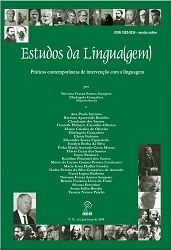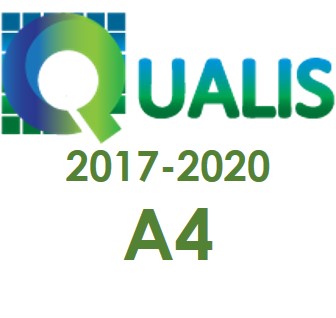Motor stereotypes in multimodal language functioning: discussions in the field of autism
DOI:
https://doi.org/10.22481/el.v17i1.5318Keywords:
Autism; Motor stereotypies; Multimodality; Language clinic.Abstract
Studying motor stereotypies from the multimodal functioning of the language of children diagnosed with Autistic Disorder is a productive way to think of stereotypies as a semiotic means to language constitution. We understand that the subject is constituted in/by language as an enunciative and multimodal instance. From the case study of three autistic children participating in the Group of Studies and Assistance to the Autistic Spectrum - GEAUT / UNICAP, this article proposes to discuss motor stereotypies in the multimodal functioning of language taking into consideration the specificity of autism and the interactive contexts of negation. The data showed that motor stereotypies integrated with other multimodal features of language produced a sense of negation effect. Therefore, they assume a relevant role as a semiotic and an enunciative way of autistic subjects being in language, representing the singularity of the subject. These findings indicate the possibility of motor stereotypies taking the place of signifiers in the language clinic.
Downloads
References
BARROS, I. B. R.; FONTE, R. F. L. Estereotipias motoras e linguagem: aspectos multimodais da negação no autismo. Revista Brasileira de Linguística Aplicada, v. 16, n. 4, Belo Horizonte, out./dez. p. 745-763, 2016.
BECHARA, E. Moderna gramática portuguesa. 37. ed. Rio de Janeiro: Nova Fronteira, 2009.
BENITEZ-QUIROZ, C. F; WILBUR, R. B.; MARTINEZ, A. M. The not face: A grammaticalization of facial expressions of emotion. Cognition 150, p. 77-84, 2016.
BENVENISTE, E. Problemas de linguística geral I. 5 ed. Trad. Maria da Glória Novak e Maria Luisa Neri. Campinas, SP: Pontes, 2005. 387 p.
_______. Problemas de linguística geral II. 2. ed. Trad. Eduardo Guimarães et al. Campinas, SP: Pontes, 2006. 294 p.
BUTCHER, C.; GOLDIN-MEADOW, S. Gesture and the transition from one-to two-word speech: when hand and mouth come together. In: MCNEILL, D. (Ed.). Language and Gesture, Cambridge: Cambridge University Press, 2000. p. 235-257.
BUENO, J. S. Cegueira e estereotipias. In: MARTÍN, M. B.; BUENO, S. T. (Org.). Deficiência visual: aspectos psicoevolutivos e educativos. Trad. Magali de Lourdes Pedro. São Paulo: Santos, 2003. p.153-160.
CAVALCANTE, M. Rotinas interativas mãe-bebê: constituindo gêneros do discurso. Investigações, Recife, v. 21, p. 153-170, 2009.
CUNHA, G. R.; BORDINI, D.; CAETANO, S. C. Autismo, transtornos do espectro do autismo. In: CAETANO, S. et al. (Org.). Autismo, Linguagem e Cognição. Jundiaí: Paco Editorial, 2015. p. 13-24.
ELIA, L. O conceito de sujeito. 2 ed. Rio de Janeiro: Jorge Zahar, 2007. 80 p.
FERREIRA JÚNIOR, J. T. A criança autista na/pela linguagem: da categoria de pessoa à singularidade do sujeito no processo de enunciação. 2014. 179 f. Tese (Doutorado em Linguística) – Universidade Federal da Paraíba, João Pessoa, 2014.
FONTE, R. et al. A matriz gesto-fala na aquisição da linguagem: algumas reflexões. In: RÊGO BARROS, I. et al (Org.). Aquisição, desvios e práticas de linguagem. Curitiba: Editora CRV, 2014. p. 11-26.
FONTE, R. F. L.; CAVALCANTE, M. C. B. Abordagem multimodal da linguagem: contribuições à clínica fonoaudiológica. In: MONTENEGRO, A. C.; RÊGO BARROS, I; AZEVEDO, N. (Org.). Fonoaudiologia e Linguística: teoria e prática. Curitiba: Appris, 2016. p. 205-225.
_____; _____. Gestos dêiticos e atenção conjunta nas especificidades do autismo: uma abordagem multimodal. In: ÁVILA NÓBREGA, P. V. (Org.). Nuances da Linguagem em Uso. Campina Grande: EDUEPB, 2018. p. 159-299.
GOLDIN-MEADOW, S. How Gesture Promotes Learning Throughout Childhood. Child Development. v. 3, n. 2, p. 106-111, 2009.
HOFFMANN, S. B. Estereotipias na infância. Porto Alegre – RS, 1996. Disponível em: http://www.diversidadeemcena.net/artigo21.htm. Acesso em: 10 dez. 2015.
KANNER, L. Autistic Disturbances of affective contact. Nervous Child, New York, v.2, p.217-250, 1943.
_____. Psiquiatría infantil. Buenos Aires: Paidos e Psique, 1966. 747 p.
KENDON, A. The study of gesture: someremarks on its history. Recherches sémiotiques/semiotic inquiry, 2, p. 45-62, 1982.
_____. Language and gesture: unity or duality? In: MCNEILL, D. (Ed.) Language and gesture, Cambridge University Press, 2000. p. 47-63.
_____. Language’s matrix. Gesture, n. 9, v. 3, p. 355–372, 2009.
_____. Reflections on the “gesture-first” hypothesis of language origins. Psychonomic Bulletin & Review, 2016; 24(1): 163–170.
LAVER, J.; BECK, Unifying principles in the description of voice, posture and gesture. In: CAVE, C.; GUAITELLA, I. (Org). Interations et comportement multimodaux dans la communication. Paris, L’Harmattan, 2001. p. 46- 63.
LAZNIK, M. C. A voz da sereia: o autismo e os impasses na constituição do sujeito. Trad. Cláudia Fernandes Rohenkol et al. Salvador, BA: Ágalma, 2004. 211 p.
LEVIN, E. A Clínica psicomotora: o corpo na linguagem. Trad. Julieta Jerusalinsky. Petrópolis: Vozes, 1995. 341 p.
_____. A infância em cena: constituição do sujeito e desenvolvimento psicomotor. Trad. Endlich Orth e Ephraim Ferreira Alves. Petrópolis, RJ: Vozes, 1997. 285 p.
MCNEILL, D. So you think gestures are nonverbal? Psychological Review. v. 92, n.3, p. 350-371, 1985.
_____. Hand and Mind: What Gestures Reveal About Thought. Chicago, IL: University of Chicago Press, 1992. 409 p.
_____. Introduction. In: _____. (Ed.). Language and Gesture. Cambridge: Cambridge University Press, 2000. p. 1-10.
ORGANIZAÇÃO MUNDIAL DA SAÚDE. CID-10 - Classificação Estatística Internacional de Doenças e Problemas Relacionados à Saúde. 10. ed. rev. São Paulo: Universidade de São Paulo, 1997.
PANHOCA, I.; BAGAROLLO, M. F. Sujeitos autistas em terapêutica fonoaudiológica grupal. In: GUARINELLO, A. C. et al. (Org.). Abordagens grupais em fonoaudiologia: contextos e aplicações. São Paulo: Plexus, 2007. p. 121-137.
ROWE, M.; GOLDIN-MEADOW, S. Early gesture selectively predicts later language learning. Developmental Science, 12: 1, p. 182-187, 2009.
SIBEMBERG, N. Autismo e linguagem. Escritos da criança, Centro Lydia Coriat, nº 5, Porto Alegre: Linus Editores, 1998. p. 60-71.
SURREAUX, L. M. Sobre o sintoma de linguagem na clínica de linguagem. In: GRAÑA, C. G. Quando a fala falta: fonoaudiologia, linguística e psicanálise. São Paulo: Casa do Psicólogo, 2008.
TEIXEIRA, G. Manual do autismo. 2 ed. Rio de Janeiro: BestSeller, 2016. 91 p.
Downloads
Published
How to Cite
Issue
Section
License

Estudos da Língua(gem) is licensed under a Creative Commons Attribution 4.0 International License.
Authors who publish in the journal Estudos da Língua (gem) agree with the following terms:
The journal Estudos de Língua(gem) maintains the copyrights of the contributions published. These rights include the publication of the contribution and make its content available for free through the portal.













